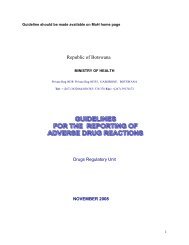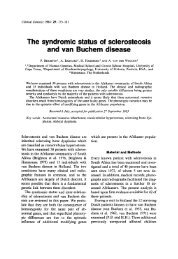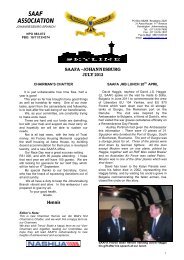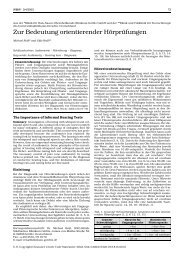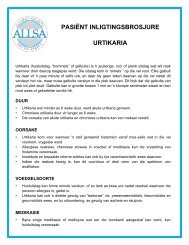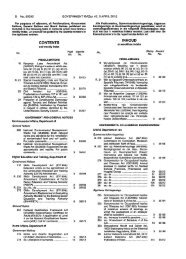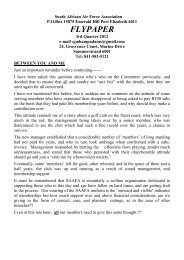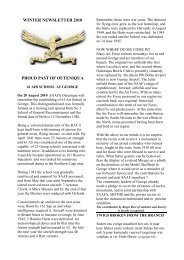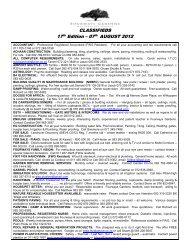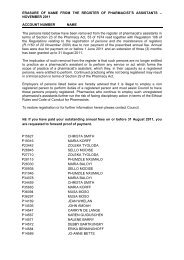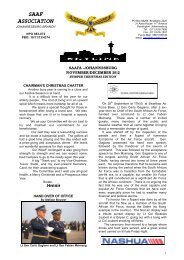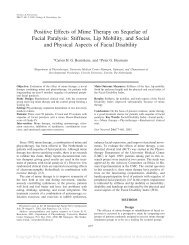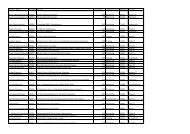Bell's Palsy: The Spontaneous Course of 2,500 Peripheral ... - Admin
Bell's Palsy: The Spontaneous Course of 2,500 Peripheral ... - Admin
Bell's Palsy: The Spontaneous Course of 2,500 Peripheral ... - Admin
Create successful ePaper yourself
Turn your PDF publications into a flip-book with our unique Google optimized e-Paper software.
Bell’s palsy 9<br />
Fig. 3. Age distribution <strong>of</strong> patients with Bell’s palsy in<br />
comparison with that <strong>of</strong> the underlying population.<br />
Side <strong>of</strong> the face<br />
<strong>The</strong>re was no difference in localization, with 828<br />
(48.7%) right- and 873 (51.3%) left-sided palsies<br />
(0.1 BpB0.2).<br />
Age distribution<br />
This subject has also been debated, without de nitive<br />
conclusions having been reached. Figure 3 demonstrates<br />
the age distribution <strong>of</strong> patients with Bell’s<br />
palsy in comparison to the age distribution <strong>of</strong> the<br />
underlying population. <strong>The</strong> incidence <strong>of</strong> Bell’s palsy<br />
reaches a maximum between the ages <strong>of</strong> 15 and 45<br />
years and this differs highly signi cantly from the age<br />
distribution <strong>of</strong> the underlying population (pB0.001).<br />
<strong>The</strong> disease is signi cantly less common below the<br />
age <strong>of</strong> 15 years and above the age <strong>of</strong> 60 years (pB<br />
0.001). For the group aged 45–59 years the incidence<br />
<strong>of</strong> Bell’s palsy did not differ signi cantly from the age<br />
distribution <strong>of</strong> the underlying population (p¾0.4).<br />
<strong>The</strong> in uence <strong>of</strong> age on the incidence <strong>of</strong> Bell’s palsy<br />
would therefore seem to be convincingly demonstrated.<br />
Symptoms<br />
<strong>The</strong> most alarming symptom <strong>of</strong> Bell’s palsy is <strong>of</strong><br />
course the paresis itself. Approximately 50% <strong>of</strong> patients<br />
believe that they have suffered a stroke, 25%<br />
fear an intracranial tumor and the remaining 25%<br />
have no clear conception <strong>of</strong> what is wrong, but are<br />
Table VI. Distribution <strong>of</strong> symptoms <strong>of</strong> Bell’s palsy<br />
among the patient sample<br />
Symptom<br />
n %<br />
Taste disorders 580 34<br />
Phonophobia 234 14<br />
Tear ow 1137 67<br />
Dry eye 69<br />
4<br />
Postauricular pains 881 52<br />
Fig. 4. Distribution <strong>of</strong> time <strong>of</strong> beginning recovery after the<br />
onset <strong>of</strong> paresis.<br />
extremely anxious. <strong>The</strong> distribution <strong>of</strong> symptoms<br />
among the patient sample is shown in Table VI.<br />
Postauricular pains, which were experienced by almost<br />
half the patients, are <strong>of</strong> the utmost interest.<br />
<strong>The</strong>se pains occurred simultaneously with the palsy in<br />
:50% <strong>of</strong> patients, whilst in 25% they occurred 2 or<br />
3 days before the onset <strong>of</strong> palsy. <strong>The</strong> remaining 25%<br />
<strong>of</strong> patients experienced pains after the onset <strong>of</strong> palsy.<br />
<strong>The</strong> pains are located deep in the mastoid region,<br />
usually persist for one to several weeks and require<br />
analgesia.<br />
Every third patient will complain about taste disorders<br />
but when examined objectively four out <strong>of</strong> ve<br />
show a reduced sense <strong>of</strong> taste. This difference can be<br />
explained by the fact that patients can still use the<br />
normal side <strong>of</strong> the tongue to taste.<br />
Only a few patients are able to perceive restricted<br />
stapedius re ex paresis, which may lead to phonophobia<br />
or diplaucusis. In comparison, two out <strong>of</strong><br />
three patients complain about tear ow. However,<br />
this is not caused by hypersecretion but by the diminished<br />
function <strong>of</strong> the musculus orbicularis oculi,<br />
which prevents tears from being transported medially<br />
to the lacrimal sac.<br />
Time <strong>of</strong> beginning recovery<br />
Very little interest has been paid in the literature to<br />
the question <strong>of</strong> recovery time and therefore it was felt<br />
worthwhile to record the pattern <strong>of</strong> remission for the<br />
idiopathic palsies. <strong>The</strong> time <strong>of</strong> the rst sign <strong>of</strong> muscular<br />
movement in relation to the onset <strong>of</strong> palsy was<br />
recorded.<br />
Of a total <strong>of</strong> 1,701 patients, 1,189 suffered from<br />
complete paralysis (70%) and 512 from incomplete<br />
paralysis (30%). Recovery occurred within 3 weeks<br />
for 1,448 patients (85%) and within 3–5 months for<br />
the remaining 253 patients (15%).<br />
<strong>The</strong> results are shown in Fig. 4. By de nition, all<br />
patients with incomplete paresis have function back<br />
at time zero, i.e. at the onset <strong>of</strong> paresis. In the rst



